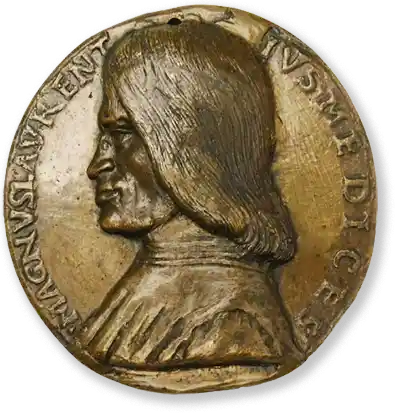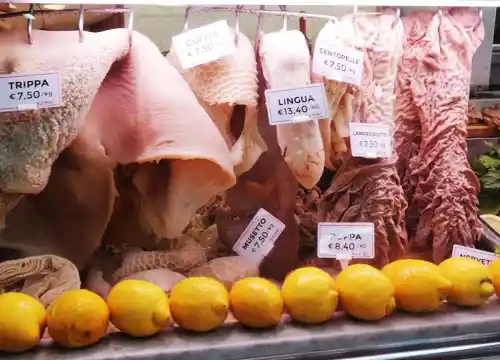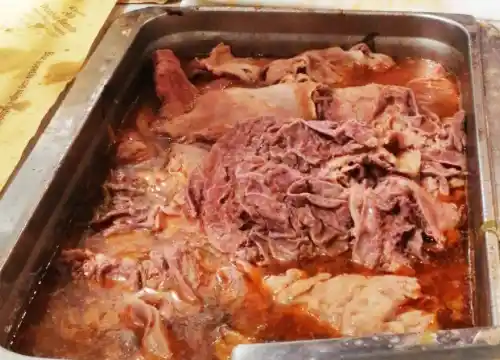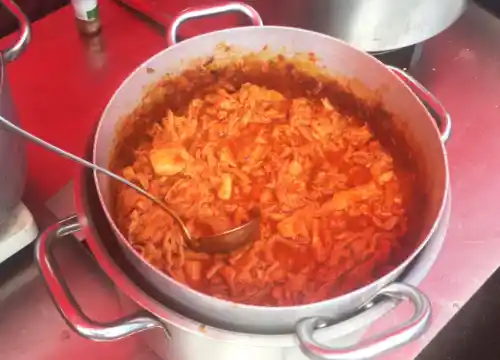Published:
Author: Antonio Maria Guerra
Lampredotto
HISTORY, INFO, PLACES, INTERESTING FACTS

If someone continues to think that street food is a modern invention, after reading this article will understand his error. In this regard, we will deepen the knowledge of Lampredotto, the exquisite sandwich stuffed with offal that has delighted the people of Florence since the 15th century, when the city, ruled by the Medici family, became the propulsive center of the Italian Renaissance.

What is Lampredotto?
Lampredotto, the typical street food of the Florentine gastronomic tradition, is a round-shaped sandwich stuffed with a specific portion of the bovine stomach, namely the abomasum, cooked by the ‘trippai’ (tripe makers), according to a recipe that has been handed down for centuries. It’s the trippai themselves that, from their ‘banchini’ (small, semi-mobile shops), sell it in the streets and squares of the Tuscan capital, tempting locals and passing tourists.

Best Lampredotto in Florence.
Here follow a short list including some of the most traditional Florentine trippai where it’s possible to enjoy the original Lampredotto:
- Trippaio del Porcellino
Piazza del Mercato Nuovo, Florence (Italy)
Tel. +39 335 8070240
Read more
- Aurelio il Re del Lampredotto
Piazza Bernardo Tanucci, Florence (Italy)
Tel. +39 339 7034530 - Lupen e Margo
Via dell’ Ariento Banco n. 75, Florence (Italy) - ‘I Trippaio di San Frediano
Piazza dei Nerli, Florence (Italy)

The History of Lampredotto.
The history of lampredotto is rooted in Florence’s glorious past.
The first records about its commercialization date back to the 15th century, at the height of the Renaissance: a period artistically unparalleled, characterized by the immense wealth of a few families (above all that of the Medici), but also by the great misery of common people. It was precisely to feed the latter that bovine entrails started to be cooked: the so-called ‘quinto quarto’ (fifth quarter), at the time very cheap. It was used in many specialties, simple and very tasty, sold for just a few coins by the so-called ‘trippai’: picturesque merchants whose stores, at the time, consisted of small wooden carts pushed by hand.
Even then, among the food offered to customers, lampredotto stood out: so, doesn’t surprise that this delicacy has many admirers still today.
Florence, the home of Lampredotto.
Florence, the home of Lampredotto, is also, and above all, the cradle of the Italian Renaissance. A unique place that, in a small space, manages to combine the grandeur of immortal works of art with the everyday life and the innate friendliness of the Tuscan people (for example, try listening to their irresistible dialect). To stroll along the city’s streets is like traveling into the past, in a glorious history that has crystallized: the visitor is gifted with atmospheres from another time, when the Medici Family ruled.

Lampredotto recipe.
The preparation method for Lampredotto is not too difficult: what really makes the difference is the quality of the ingredients (the abomasum above all), and the experience of the tripe maker (‘trippaio’) who cooks: his particular skill is necessary for some fundamental choices like for example proportions and cooking time.
Summarizing as much as possible, here follow the steps of the recipe:
Start by boiling the meat in a vegetable stock made with carrots, onion, and celery;
Separately, cook some ‘soffritto’ (fried sauce including onions, carrots, and celery), simmer it with red wine until it’s reduced, then add the cooked lampredotto and some tomato (plus other ingredients, in case of variations).
Once ready, the meat and its seasoning are placed in the ‘semelle’, the typical round-shaped sandwich from Florence, and then served to customers.
N.B. The addition of Tuscan green sauce is entirely optional.
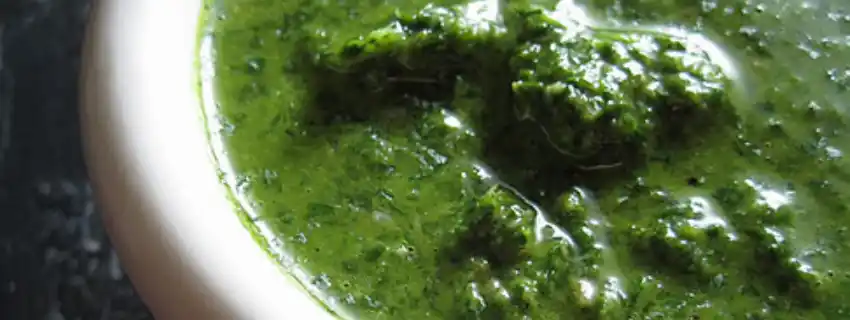
Tuscan green sauce for Lampredotto.
Despite, at first glance, one might think otherwise, Lampredotto has a very delicate taste. It’s therefore no coincidence that, to enrich it further, on request some Tuscan green sauce can be added to the sandwich: an exquisite mixture prepared with plenty of parsley, eggs, stale breadcrumbs, anchovies, garlic, olive oil, vinegar and/or lemon, salt and pepper.

Abomasum: the main ingredient.
Abomasum, the main ingredient of Lampredotto, is one of the ‘four stomachs’ of ruminants (cattle, sheep, and goats). It’s the portion that provides for the actual digestion of food after it has undergone a series of fermentative processes within the reticulum, the rumen, and the omasum.
On the palate, bovine abomasum has a tender texture and a delicate, slightly sweet taste. Due to its porosity, it can easily absorb the flavor of the vegetables and spices used in the cooking broth.

Semelle: the right bread for Lampredotto.
It may seem odd, but bread plays an important role in the preparation of Lampredotto. Tradition wants that, when making the specialty, ‘semelle’ should be used: it’s a round-shaped bun, salted and characterized by an abundant and compact crumb. Its name derives from the German ‘semmel’ (‘bun’) and, digging further in the past, from the Latin ‘simila’ (‘flour flower’). Because of the large cut on its surface, this bread was also known as ‘Passerina’, possibly for its resemblance with women’s genitalia. In conclusion, it should be noted that, nowadays, more and more ‘trippai’ (the tripe makers), prefer to use the so-called ‘Rosetta’ for their Lampredotto: it’s a type of bun much lighter than Semelle.
The preparation in video.
In this video, shot at the traditional ‘Tripperia al Porcellino’, its owner, Mr. Orazio, shows us the method he uses to make the original Florentine Lampredotto. Many hanks to Munchies (by Vice), the YouTube channel that produced the footage.


Trippai: the ‘masters of Lampredotto’.
That of the ‘trippaio’ is one of Florence’s oldest trades: the repository of a culinary tradition that has survived unchanged for centuries and centuries. It is known for a fact that, as early as the 15th century, these particular merchants traversed the streets and squares of the Tuscan capital, pushing their wooden carts: in exchange for a few coins, they sold their tasty wares to the populace. Quite soon, they united into a full-fledged corporation, a sort of consortium ante litteram, so that they could protect their interests.
Then as now, among the most famous specialties of these artists, in addition to Lampredotto it is necessary at least to mention other delicacies such as, for example:
- Trippa alla Fiorentina: delicious tripe prepared with tomato, white onion, carrot, celery, and grated Parmesan cheese;
- Poppa, or cow udder, which can be served raw (accompanied by lemon) or cooked in broth;
- Stracotto di Guancia, consisting of beef cheek slowly cooked in a stew;
Many other tasty specialties should be added to these, often based on offal.
Nowadays trippai practice their profession in small, semi-mobile structures, known as ‘banchini’, combining kitchen and shop in one place.

The origins of the name.
There are no certainties regarding the origins of the name ‘lampredotto’. Currently, the most likely hypotheses are two:
The first associates it with the similarity between the Florentine specialty and the mouth of the lamprey, a particular fish variety.
The second, frankly more plausible, suggests that ‘lampredotto’ could be the nickname assigned to a specialty (the sandwich famous still today), invented as a ‘poor’ alternative to the lamprey: a fish that, in the past, could not go missing from the tables of wealthier people.


The great success.
Strange as it may seem, Lampredotto has not always enjoyed a good reputation: for centuries it has been considered just food for the poor people and, as such, mostly undervalued. In this regard, the trippai themselves, those who have always prepared the specialty, were not held in high regard: suffice to say that for much time, to call someone ‘trippaio’ meant that he was a stupid, if not worse. In recent years, thanks to social networks, Lampredotto, like a sort of ‘Cinderella of taste’, has become so famous and coveted that large crowds of tourists come from all over the world to savor it.

Chianti wine for Lampredotto.
Although an experienced sommelier might suggest many better pairings, Lampredotto is often accompanied by a glass of the most famous Tuscan wine, Chianti, which can be purchased for a few euros in the same place where the specialty is offered to customers.
Copyright information.
The images displayed in this page belong to WebFoodCulture, with the exception of:
Pubblic Domain Images
Creative Commons Images
- “Lampr. sandwich” by yqtravelling is licensed under CC BY-NC-SA 2.0.
- “File:Lampr. sandwich.JPG” by Lucarelli is licensed under CC BY-SA 3.0.
- “Niccolò fiorentino, medaglia di lorenzo de’ medici, 1490 ca” by Niccolò di Forzore Spinelli is licensed under CC BY 3.0.
- “Italian Salsa Verde – The Delicious Daily 11.21.2009” by TheDeliciousLife is licensed under CC BY 2.0.
- “Lampr.” by George M. Groutas is licensed under CC BY 2.0.
- “Stemma di Firenze”, by Connormah is licensed under CC BY 3.0 Unporeted.
- “L’antico trippaio” by grobery is licensed under CC BY 2.0.
- “Lampredottai in Firenze.jpg” by Fabio Venni is licensed under CC BY-SA 2.0.

